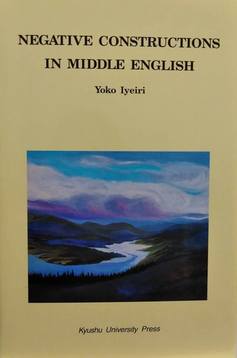Yoko Iyeiri, Negative Constructions in Middle English (Kyushu University Press, 2001)

7,000 yen
Negative Constructions in Middle English derives from my Ph.D. thesis submitted to the University of St Andrews in 1992 (“Negative Constructions in Selected Middle English Verse Texts”). While the thesis discusses Middle English negation on the basis of selected verse texts, this book explores additional Middle English texts mainly written in prose. The texts studied in this publication are:
Verse
Poema Morale, La3amon’s Brut, The Owl and the Nightingale, King Horn, Havelok, The South English Legendary, English Metrical Homilies, The Middle English Genesis and Exodus, The Poems of William of Shoreham, Cursor Mundi, Sir Ferumbras, Confessio Amantis, Handlyng Synne, Kyng Alisaunder, Pearl, Cleanness, Patience, Sir Gawain and the Green Knight, The Canterbury Tales (verse), The Alliterative Morte Arthure, Alexander and Dindimus, The Destruction of Troy, The York Plays, The Stanzaic Morte Arthur
Prose
The Peterborough Chronicle 1070-1154, History of the Holy Rood-Tree, Twelfth-Century Homilies in MS. Bodley 343, Dan Michel’s Ayenbite of Inwyt, The Earliest Complete English Prose Psalter, The Northern Prose Version of the Rule of St. Benet, The Canterbury Tales (prose), A Late Middle English Treatise on Horses, English Prose Treatises of Richard Rolle de Hampole, Mandeville’s Travels, The Cloud of Unknowing, John Capgrave’s Abbreuiation of Chronicles, Paston Letters and Papers of the Fifteenth Century, The History of Reynard the Fox, Caxton’s Own Prose, Paris and Vienne
The following is the list of contents of this book.
Contents
INTRODUCTION
1.1. The aim of the present book
1.2. Previous research into English negative constructions with special reference to ME
1.3. Texts examined
HISTORICAL DEVELOPMENT OF ME NEGATIVE CONSTRUCTIONS
2.1. Negative elements
2.2. Chronological and geographical development of negative adverbs ne and not
2.3. Development of negative clauses with never, no, etc.
2.4. Negative clauses which include negative conjunctions only
SYNTACTIC VARIETIES OF NEGATION
3.1. Word order concerning the adverb ne
3.2. The adverb not preceding the finite verb
3.3. The adverb not which does not directly follow the finite verb
NEGATIVE CONSTRUCTIONS AND THE NATURE OF THE FINITE VERB
4.1. Negative constructions and forms of be, have, will, and witen
4.2. Negative constructions and modal auxiliary verbs
4.3. Negative constructions and contracted verbs
NEGATIVE CONSTRUCTIONS AND SYNTACTIC CONDITIONS
5.1. Preliminary remarks
5.2. Negative interrogative clauses
5.3. Conditional clauses
5.4. That-clauses dependent upon a negative clause
5.5. That-clauses dependent upon douten ‘to doubt’, forbeden ‘to forbid’, etc.
5.6. Expletive negation after certain conjunctions
5.7. Clauses with forms of witen followed by an interrogative
5.8. Some other syntactic conditions related to the use of the adverb ne
5.9. Imperative and optative clauses
5.10. Clauses in which the finite verb immediately follows the conjunction ne
5.11. Declarative clauses in which the verb precedes the subject
5.12. Figurative negation
5.13. Existential clauses
5.14. Some idiomatic expressions
MULTIPLE NEGATION
6.1. Some preliminary remarks on multiple negation
6.2. Historical overview of single and multiple negation in ME
6.3. Multiple negation with the negative adverb ne (Type 1)
6.4. Multiple negation with conjunctive ne/nor (Type 2)
6.5. Multiple negation with the combination of not, neither, never, no, etc. (Type 3)
6.6. Multiple negation with neither
6.7. Decline of multiple negation and the development of and and or
6.8. Decline of multiple negation and the development of any, ever, etc.
NEGATIVE CONTRACTION
7.1. Some preliminary remarks on negative contraction
7.2. Dialectal distribution of negative contraction in ME
7.3. Geographical versus chronological conditions
7.4. Negative contraction and syntactic conditions
SUMMARY AND CONCLUSIONS
Appendix
Bibliography
Index
Related publications
- Iyeiri, Yoko. 2004. “The Use of the Auxiliary Do in Negation in Tom Jones and Some Other Literary Works of the Contemporary Period”, in New Trends in English Historical Linguistics: An Atlantic View, ed. Isabel Moskowich-Spiegel Fandiño & Begoña Crespo García, pp. 223-40. Coruña: Universidade da Coruña.
- Iyeiri, Yoko. 2007. ”Decline of Some Middle English Features of Negation in the Fifteenth Century: A Study of The Paston Letters“, in Language and Beyond: A Festschrift for Hiroshi Yonekuraon the Occasion of his 65th Birthday, ed. Mayumi Sawada, Larry Walker, & Shizuya Tara, pp. 249-63. Tokyo: Eichosha.
- Iyeiri, Yoko. 2010. “Negation in Different Versions of Chaucer’s Boece: Syntactic Variants and Editing the Text”. English Studies 91: 826-837.
- Iyeiri, Yoko. 2010. “Negation in Fragments A, B and C of the Hunter Manuscript of The Romaunt of the Rose“, in Language Change and Variation from Old English to Late Modern English: A Festschrift for Minoji Akimoto, ed. Merja Kytö, John Scahill & Harumi Tanabe, pp. 79-101. Bern: Peter Lang.
- Iyeiri, Yoko. 2013. “Cognitive Aspects of Negation in The Tale of Melibee, The Parson’s Tale, and A Treatise on the Astrolabe“, in Chaucer’s Language: Cognitive Perspectives, ed. Yoshiyuki Nakao & Yoko Iyeiri, pp. 5-25. Suita: Osaka Books.
See also my project page on negation in the history of English.
